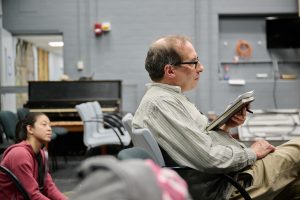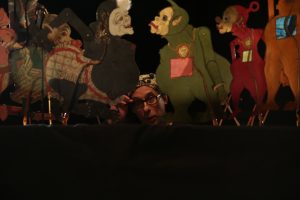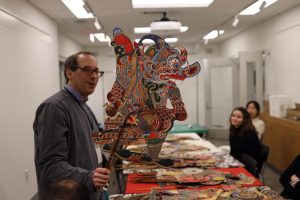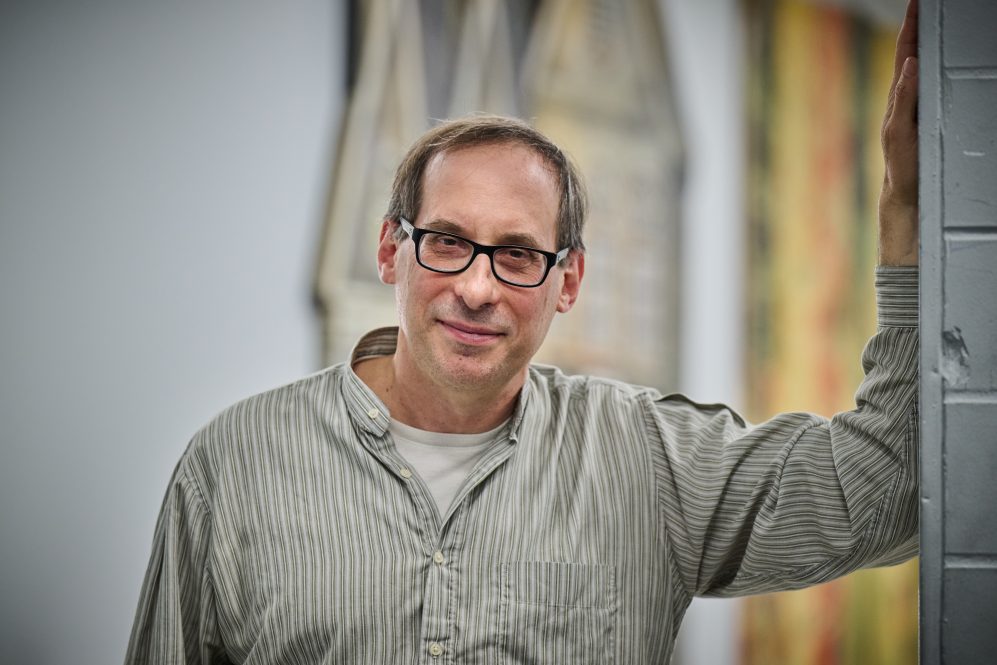Matthew Isaac Cohen has laid hands on each of the 23,000 puppets that comprise the largest Indonesian puppet collection in the world.
Over the last eight years, as the UConn Puppet Arts professor has researched the Dr. Walter Angst and Sir Henry Angest Collection of Indonesian Puppets at the Yale University Art Gallery, Cohen has taken great care with each of the artifacts, some hundreds of years old.
The collection came to Connecticut from Europe, after the Swiss-born Angst spent a lifetime making annual trips to the archipelago to amass what is now also the largest puppetry collection of any kind in North America.
Massive wooden chests, some hand carved and requiring the strength of several people to lift, were home to Angst’s puppets, maintained as full sets in just the way puppeteers, anthropologists, and historians like Cohen want to see them.
“Opening up one of these chests, you never could be quite sure what you’d see inside,” he says. “I’ve been working in this area for a long time, and I’d find surprising forms of puppets that I’d never seen before, along with little Easter eggs like newspapers used for lining the box or bits of resin used as incense.

“There were puppets sitting at the bottom of boxes that didn’t really belong there, but Walter had introduced them because he felt they would be in good company. Every box had these kinds of surprises,” he continues.
One-by-one, Cohen lifted each treasure, putting fingerprints on pieces of history that had been used to tell stories for generations, most from the time they were created until Angst’s acquisition.
But one set already had felt Cohen’s touch – his fingerprints layered in among those from other wayang puppeteers who’d handled them over the decades.
“There was a set that I used in the late ’80s and early ’90s when I was studying with a puppeteer named Oemartopo who had borrowed them from a neighbor who also was a puppeteer,” Cohen says. “We would go to his neighbor’s house every Friday night and have a practice session using that set of puppets and musical instruments that went with them.”
Cohen, a member of the prestigious John Simon Guggenheim Memorial Foundation’s 100th class of fellows, the only one from UConn in 2025-26, plans to document in two major publications what he’s found in Angst’s collection, even as he relives his own experiences along the way.
Guggenheim Stays with You
“This is a generous award that puts me into some remarkable company,” Cohen says of his fellowship. “If you look back at the people in my field who have received a Guggenheim, it’s a ‘who’s who’ of American theater. Being a Guggenheim is not just about getting funding for a year, it’s an honor that stays with you for your career.”
The award, he says, is the culmination of his work on the Angst collection, which he helped bring to Yale in 2017 and has researched through a series of other fellowships and awards. After Angst’s death in 2014, the collection went to his brother Angest, who ultimately donated them to Yale, which then had a newly established Indo-Pacific art department in addition to other well-known Indonesia-related programs.

Cohen says his first major project is to finish a monograph on the history of wayang puppetry over the last 200 years, the first with that kind of scope. It also will be unique in that he plans to make the puppets characters who witness historical events and changes over the centuries.
It’s a literary device that he says he contrived after a haptic experience with the puppets brought them to life, capable of movement much like a living person and therefore able to bear witness to the world around them.
His second fellowship project is to publish a catalog of the Angst collection meant to introduce a general audience to its individual artifacts and get them thinking about puppets as storied objects.
“These are puppets that come with a sense of character, and character exists in narratives, which are realized in performance,” Cohen says. “This publication is going to look at particular puppets as modern interpretations of characters from well-known stories set alongside the traditional forms.”
For instance, the well-known Asian character Semar, a clown servant used often in wayang puppetry, will appear in a Teletubby costume – still Semar, Cohen says, just dressed differently. It’s a pairing most people wouldn’t imagine on their own.
‘Entranced by this art form’
Cohen says his interest in Indonesia goes back to the 1980s, when as an undergraduate at Harvard University he joined other Americans in taking an interest in seemingly novel things coming out of Asia.
“Sushi was newly introduced here,” he says, “and my roommates and friends were busy studying Chinese and Japanese languages because everyone believed the next century would be the Asian century. I was watching Butoh dance theater from Japan and Peter Brook’s massive ‘Mahabharata’ at the Brooklyn Academy of Music.
“I was interested where those things came from, not particularly in puppets, but I gravitated to Indonesia through a confluence of things,” he says, including an ethnomusicology professor who suggested playing gamelan, the traditional music of wayang.
Even though he was a psychology major interested in child’s play and temperament, Cohen says he started to imagine what it would be like to be an auteur-director, that is having an intimate creative fingerprint on a production from script to music to direction to performance, and how puppeteers often play that role in their work.
When he went to Indonesia in 1988, he says he expected to stay off to the side, there to observe the puppet traditions of the country. But the conservatory that sponsored his Fulbright scholarship had other ideas, and enrolled him in private puppetry lessons, no questions asked.
“Once I started to do these practical studies, which are incredibly involved and very physical, I was entranced by this art form that has occupied a lot of my life since,” he says. “It’s not the only thing I do, but it’s one of my areas of expertise. This art form is so complicated that you can’t just study it for a year and think you know much. It’s something that needs many decades to appreciate at a deep level.”
Preserving Puppet History
Walter Angst was a biologist, not a historian or puppeteer, and only a hobbyist when it came to wayang puppetry, Cohen says. Nonetheless, the 40-year hobbyist made annual trips to Indonesia, condensing vacation time for an extended stay overseas, and brokered large puppet purchases with dealers who became his trusted informants.
“At the end of the day, he’d spend time communing with his puppets. He’d make notes about them, air them out, and make sure they were well maintained,” he says. “Walter felt that he was on a mission to save the diversity of wayang as an art. Biodiversity was one of his specializations as a biologist, and he worked on endangered species. That was his understanding of what he was doing with his puppet collection.”
The Angst collection has three main forms of puppetry in the wayang tradition, Cohen says. Shadow puppets comprise most of the lot, with 3D rod puppets known as wayang golek and flat wooden puppets known as wayang klitik making up the rest.
The shadow puppets are made of animal hide – buffalo in the better-quality ones – that has been stretched, dried, and chiseled to give them detail. Two sets, Cohen says, are from the royal courts and depict exquisite detail, especially in lace work so intricate it’s hard to imagine a human could have done it.
“Still, after years of working with these puppets, it’s extraordinary for me to see,” he says.
Yale has Angst’s collection preserved as a study collection with sets of puppets kept together instead of arranging them in some other way, say by size or type.
The full collection is so large not all of it is on view, although the Yale University Art Gallery does have a permanent exhibition of selections from two of the 140 sets in the full collection.

Cohen says the Indonesian puppet tradition is one of the oldest globally and dates back about 1,000 years, although no puppets in the Angst collection, or anywhere for that matter, are that old. Historians have images of puppets etched in stone from about 800 years ago – “Nothing survives like that in the tropics,” he quips.
Shadow puppetry is a product of simultaneous invention, Cohen explains, popping up in the northern part of Africa, China, India, and Indonesia around the same time, although it’s the Indonesian tradition that’s enjoyed the most popularity.
“This is one of the most important art forms in Indonesia and occupies the highest level of prestige,” he says. “People name their kids after puppets and presidents and kings collect and perform with puppets. It’s not a marginal art form for children. It’s a highly prestigious, celebrated form of culture.”
Today, performances are routinely livestreamed, and in the case of one popular performer who drew an in-person audience of 500 to 1,000 to a recent show, up to 40,000 people worldwide watched online.
“Wherever there are Indonesian migrants, they are often some of the most devoted fans interested in supporting wayang because it allows them to feel part of the cultural community,” Cohen says.
And as he opened each of Angst’s wooden chests, that cultural community became more rooted for posterity.
“It’s not to say that at this moment it’s not challenged by other media that are available,” Cohen says. “But it’s an art form that appeals to different ages and socioeconomic statuses. It crosses religious barriers and lines. It’s a rich art form with a very long history.”



